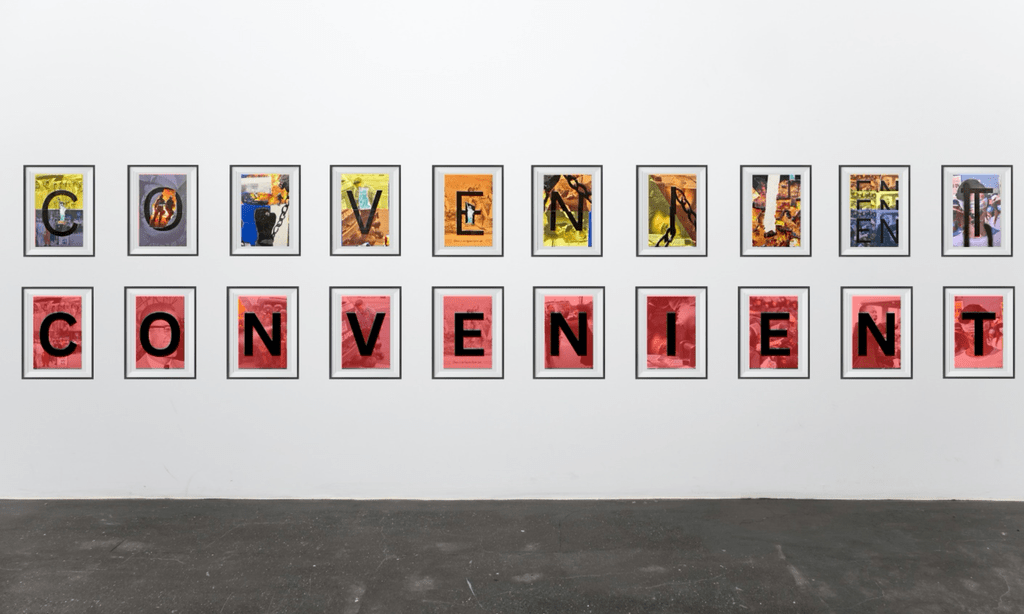Will Brewster, Ben Levine, Ryan Reigle, Huynh Tran, Ella Woodruff
Digital Mixed Media

For our project, we wish to archive our work as if it were to be held in a museum, reflective of our experience throughout the Walker. Our group chose to create a collage of images that, when pieced together along a left-to-right axis, would spell out the world “CONVENIENT.” The choice of the word as well as the images that underlie the letters was the result of the fact that our initial ideas aligned. All of us, in some form or another, looked to the ways in which African Americans have historically and contemporaneously been discriminated against. We all wanted to express some form of linearity or a representation of time through space. In addition to this, we all felt that an aspect of this form of racial discrimination can be found in MLK’s notion of the “white moderate,” who sympathized with the logos of African Americans but disagreed with how they should achieve their goals of equality and political representation. We wanted to play with these two ideas, linearity as well as the notion of the “white moderate” which we chose to be representative of this notion of convenience. African American progress is only seen as convenient to political moderates, both black and white, when it goes through typical channels of achieving political representation in legislative bodies and perhaps changes in legal statutes without necessarily a change in attitudes and beliefs, as demonstrated by the Civil Rights cases in the late-19th century. The Civil Rights movement, King being a big part of that, challenged the political moderates of the mid-20th century to question their assumptions concerning how historically or non-historically marginalized groups ought to try and achieve equality.
We also engaged the larger thematic issues of appropriation, taking images throughout American history that showcase the struggles of African Americans, images such as etchings of the Fugitive Slave Act of 1793 and photographs of 21st century police brutality. Instead of simply taking the images from the internet and placing them bare, we decided to camouflage them with the letters of ‘convenient’. These images take on a new life once the letters are placed onto them as certain key scenes of interest may be partially covered or wholly concealed. Furthermore, these letters may in fact emphasize or highlight key actions of the image, such as the way in which the ‘V’ in front of the brutal murdering of George Floyd focuses your eye on the tension that rests on Floyd’s neck from the police officer’s foot. As such these images as a constellation of ideas take on an entirely new role and power when they are taken from their original contexts and meshed together.
However, when it came time to actually materialize our idea, we noticed that simply rendering the word convenient across the board would not catch the audience’s eye enough and would not create the reflection we desired. As such, we decided to mix up both the color of the letters, the orientation of the letters, as well as even the location of the letters on the board. At times we would place half on a red ‘O’ with the other half of a yellow ‘O’ but would even flip the orientation which would have an interesting effect on the image in the background. In such an instance we flipped the image of Malcolm X, and used two different colors which made discerning Malcolm X exceedingly difficult. Furthermore, peoples from other groups decided to integrate their own work into the letters and images we created in such a way where the intention is muddled and the image takes on an entirely new meaning. If you follow the original chain, from an image of say Martin Luther King Jr. to an upside-down image of MLK, rendered in two different colors, a large letter overlaid, with the work of different groups interspersed throughout the image; the resulting piece is a mangled, complicated and even wrongful representation of the word “CONVENIENT.” The piece requires attention if one wishes to even see the word convenient as well as deep attention to registering what the image is behind the letter. This piece disrupts both the continuity of the word as well as the linearity of the way African Americans have been marginalized in the United States.